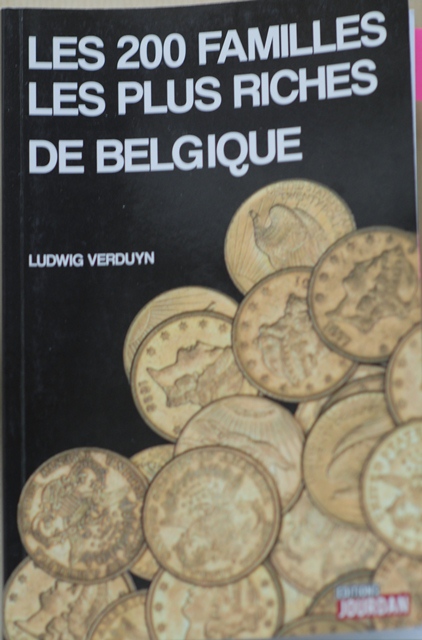 The previous day I stumbled upon a book, called ‘The Richest 200 Families of Belgium’ in a nearby bookshop and bought it on impulse. An American survey agency had previously published the ‘World Ranking of Countries Where Most Millionaires Live’ (2013)—Belgium ranked 12th in the world (Japan was in 11th place), and looking only at Europe: Belgium came in second after Switzerland. By the way, there was also a ‘Ranking of Countries with the Highest Cost of Living’, in which Belgium ranked 8th place (Japan: 6th). According to latest version of ‘The World’s Billionaires’, published yearly by Forbes: the richest person in Belgium is the 88-year old banker Albert Frère, who has a total asset of 4.9 billion dollars, ranking him 295th in the world. According to the book, mentioned in the beginning, the Frère family is ranked 18th in Belgium—somewhat surprisingly, there is a discrepancy between the individually- and family-owned assets. The family that is ranked number one in that book is the Janssen family, who are comprised of top executives from the chemical and pharmaceutical industry to major banks. The current head of the family is Nicolas Janssen—he has ties with the Belgian royal family through his wife, who is the elder sister of Queen Mathilde. So, the ranking is of no surprise. Though, a puzzling person appeared in the list—Patokh Chodiev—who for several years was said to be richer than Albert Frère, and who acquired Belgian nationality, but was born in Uzbekistan and currently lives in Kazakhstan. He is a person with a strange history—when he was young, he learnt Japanese in Moscow and lived in Japan until he began setting up a mining business in Eastern Europe and Africa. Four years back he was ranked 287th in Forbes’ World’s Billionaires list. In this year’s latest version, he fell down to 962nd place at 1.9 billion dollars. He had been rumoured to be linked to tax evasion and the mafia, and was omitted from the list of richest Belgians in the book I mentioned above. It would seem the world has a variety of affluent people…
The previous day I stumbled upon a book, called ‘The Richest 200 Families of Belgium’ in a nearby bookshop and bought it on impulse. An American survey agency had previously published the ‘World Ranking of Countries Where Most Millionaires Live’ (2013)—Belgium ranked 12th in the world (Japan was in 11th place), and looking only at Europe: Belgium came in second after Switzerland. By the way, there was also a ‘Ranking of Countries with the Highest Cost of Living’, in which Belgium ranked 8th place (Japan: 6th). According to latest version of ‘The World’s Billionaires’, published yearly by Forbes: the richest person in Belgium is the 88-year old banker Albert Frère, who has a total asset of 4.9 billion dollars, ranking him 295th in the world. According to the book, mentioned in the beginning, the Frère family is ranked 18th in Belgium—somewhat surprisingly, there is a discrepancy between the individually- and family-owned assets. The family that is ranked number one in that book is the Janssen family, who are comprised of top executives from the chemical and pharmaceutical industry to major banks. The current head of the family is Nicolas Janssen—he has ties with the Belgian royal family through his wife, who is the elder sister of Queen Mathilde. So, the ranking is of no surprise. Though, a puzzling person appeared in the list—Patokh Chodiev—who for several years was said to be richer than Albert Frère, and who acquired Belgian nationality, but was born in Uzbekistan and currently lives in Kazakhstan. He is a person with a strange history—when he was young, he learnt Japanese in Moscow and lived in Japan until he began setting up a mining business in Eastern Europe and Africa. Four years back he was ranked 287th in Forbes’ World’s Billionaires list. In this year’s latest version, he fell down to 962nd place at 1.9 billion dollars. He had been rumoured to be linked to tax evasion and the mafia, and was omitted from the list of richest Belgians in the book I mentioned above. It would seem the world has a variety of affluent people…
< Spa: The Town of Water and Mineral Spring >
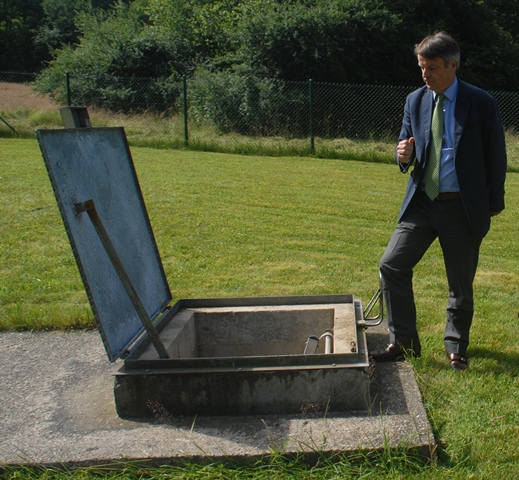
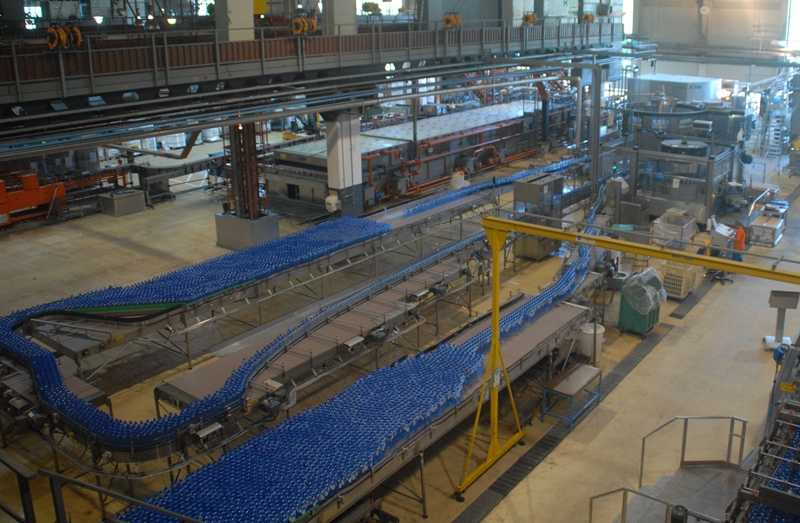 When saying the word ‘spa’ in Japan or elsewhere, one means the generic term for hot springs or thermal resorts, but in Belgium it is a different story. About 140 km southeast of Brussels lays the town of Spa (population: 10,500), which is home to a mineral spring resort, which gave rise to the proper noun ‘spa’. In addition, the mineral water known as ‘Spa’ is widely drunk in Belgium—this is drinking water gained in large quantities from the catchment area in the vicinity of the town of Spa. In other words: it would seem that in Belgium ‘Spa’ is the name of a town and its water and mineral spring, which came to be known in the rest of the world as the general term for hot springs and thermal resorts.
When saying the word ‘spa’ in Japan or elsewhere, one means the generic term for hot springs or thermal resorts, but in Belgium it is a different story. About 140 km southeast of Brussels lays the town of Spa (population: 10,500), which is home to a mineral spring resort, which gave rise to the proper noun ‘spa’. In addition, the mineral water known as ‘Spa’ is widely drunk in Belgium—this is drinking water gained in large quantities from the catchment area in the vicinity of the town of Spa. In other words: it would seem that in Belgium ‘Spa’ is the name of a town and its water and mineral spring, which came to be known in the rest of the world as the general term for hot springs and thermal resorts.
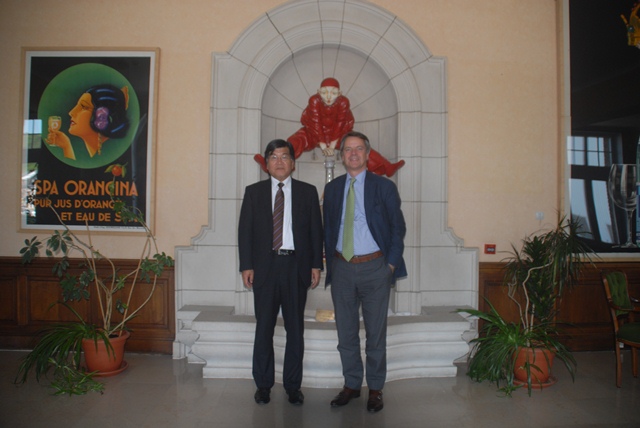 Now, the previous week I was invited by Marc du Bois, president of the Spadel Company, which produces the Spa mineral water, to visit the production area. To be more exact: Spadel is a holding company, and besides two Belgian locations, it also produces water in France and the UK. The factory at Spa is a subsidiary company with the name Spa Monopole. The 13,000 ha of plateau ground of Spa Monopole has forty-two water sources—the natural water flowing 20 to 200 metres underground, is bottled without any treatment. The factory, located in the centre of the town, holds a fully automated installation. Seeing the bottling procedure at a pace of 40,000 bottles per hour was the best part. According to Mr du Bois, the collection of the natural drinking water in Spa and exportation abroad began in 1583. Spa Monopole was established about a hundred years back in 1912. Afterwards, in the 1920s, the company got into the hands of the grandfather of Mr du Bois and since then was run by the du Bois family. The underground water of Spa is featured by its low mineral and salt content, making it easy to drink (towards children?). It is also low in carbon dioxide; therefore carbonic acid gas is added to make sparkling water. Spadel has 210 million euros (about 30 billion yen) in annual revenue and ranks 14th–15th amongst medium-sized corporations in Europe as a distributor of mineral water. Concrete talks of export to Japan were in the making in the 1990s, but nothing has been realised as of yet.
Now, the previous week I was invited by Marc du Bois, president of the Spadel Company, which produces the Spa mineral water, to visit the production area. To be more exact: Spadel is a holding company, and besides two Belgian locations, it also produces water in France and the UK. The factory at Spa is a subsidiary company with the name Spa Monopole. The 13,000 ha of plateau ground of Spa Monopole has forty-two water sources—the natural water flowing 20 to 200 metres underground, is bottled without any treatment. The factory, located in the centre of the town, holds a fully automated installation. Seeing the bottling procedure at a pace of 40,000 bottles per hour was the best part. According to Mr du Bois, the collection of the natural drinking water in Spa and exportation abroad began in 1583. Spa Monopole was established about a hundred years back in 1912. Afterwards, in the 1920s, the company got into the hands of the grandfather of Mr du Bois and since then was run by the du Bois family. The underground water of Spa is featured by its low mineral and salt content, making it easy to drink (towards children?). It is also low in carbon dioxide; therefore carbonic acid gas is added to make sparkling water. Spadel has 210 million euros (about 30 billion yen) in annual revenue and ranks 14th–15th amongst medium-sized corporations in Europe as a distributor of mineral water. Concrete talks of export to Japan were in the making in the 1990s, but nothing has been realised as of yet.
< Ghent Flower Festival >
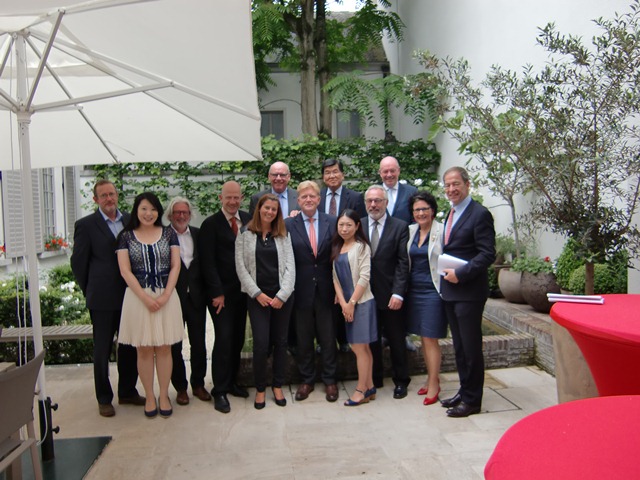 Once every five years, Ghent, Belgium’s third largest city, organises the Ghent Floralies flower festival, as you probably know. Much to my surprise, it was first held in 1809, before Belgium’s independence, and has continued to exist for over two-hundred years. The previous festival was held in 2010, so next time would be in 2015, but since a big change in plans is foreseen to happen, it will be held in 2016. Each time, from April to May, several places in the centre of the city serve as a stage for the festival for ten days. Three-hundred thousand visitors in total are expected for the coming festival. The halls will have a total area of 45,000 square metres and will be the largest indoor gardens in the world. About three months back, I got acquainted with Michel Vermaerke, board chairman of the NGO hosting the event, but the previous week we met again at the residence of Jan Briers, Governor of East-Flanders, where he hosted a luncheon for us. There we discussed the possibility of Japan participating as a specially-invited country in the 2016 event. Mayor of Ghent, Daniel Termont, and Honorary Consul-general of Japan, Piet Steel, also attended the luncheon meeting. 2016 will mark the 150-year anniversary of Japan-Belgium relations. Therefore it would be wonderful to have Japan be able to participate as a specially-invited country at this large event.
Once every five years, Ghent, Belgium’s third largest city, organises the Ghent Floralies flower festival, as you probably know. Much to my surprise, it was first held in 1809, before Belgium’s independence, and has continued to exist for over two-hundred years. The previous festival was held in 2010, so next time would be in 2015, but since a big change in plans is foreseen to happen, it will be held in 2016. Each time, from April to May, several places in the centre of the city serve as a stage for the festival for ten days. Three-hundred thousand visitors in total are expected for the coming festival. The halls will have a total area of 45,000 square metres and will be the largest indoor gardens in the world. About three months back, I got acquainted with Michel Vermaerke, board chairman of the NGO hosting the event, but the previous week we met again at the residence of Jan Briers, Governor of East-Flanders, where he hosted a luncheon for us. There we discussed the possibility of Japan participating as a specially-invited country in the 2016 event. Mayor of Ghent, Daniel Termont, and Honorary Consul-general of Japan, Piet Steel, also attended the luncheon meeting. 2016 will mark the 150-year anniversary of Japan-Belgium relations. Therefore it would be wonderful to have Japan be able to participate as a specially-invited country at this large event.
< The Sint-Niklaas Hanga Exposition >
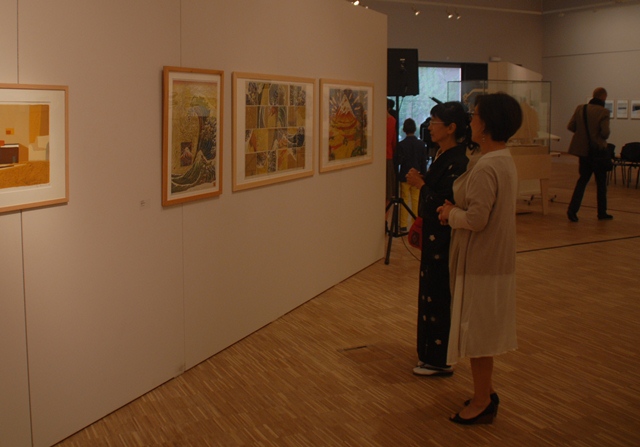
 At the end of the previous month, the Belgium-Japan Joint Hanga Exposition was held at an exposition hall in Sint-Niklaas (47 km to the northwest of Brussels; population: 72,300). Amongst the artists on display were twenty-eight Japanese and twenty Belgians, and more than 150 works filled the large hall. I was invited for the opening day ceremony (350 people attended) and received personal explanations of the works by some artists. What made this hanga exposition unique was that the works of the artists from both Japan and Belgium were displayed at random. As such, it made it difficult to know, taking a quick glance, which work might be Japanese or which might be Belgian. Amongst the Japanese works were ‘ukiyo-e’-motived and goldfish-design works, which made it apparent which nationality the artist had, but the majority were abstract works and therefore hard to really know. However, oddly-enough, when making your way around the exposition a second time, you could kind of start to discern the different feelings the artists of both countries bring, and it became easier to guess the nationality of the artists. There are many creating methods and it would be hard to sum up ‘hanga’ in just one word—there are also works with true-to-life drawings. The Joint Hanga Exposition was held in Kyoto three years back and gained much success. Several of those exhibitors became interested and the exhibition came to be held in Sint-Niklaas. In my opening address, I wished for a third Joint Exhibition to celebrate the 150-year anniversary of Japan-Belgium relations in 2016.
At the end of the previous month, the Belgium-Japan Joint Hanga Exposition was held at an exposition hall in Sint-Niklaas (47 km to the northwest of Brussels; population: 72,300). Amongst the artists on display were twenty-eight Japanese and twenty Belgians, and more than 150 works filled the large hall. I was invited for the opening day ceremony (350 people attended) and received personal explanations of the works by some artists. What made this hanga exposition unique was that the works of the artists from both Japan and Belgium were displayed at random. As such, it made it difficult to know, taking a quick glance, which work might be Japanese or which might be Belgian. Amongst the Japanese works were ‘ukiyo-e’-motived and goldfish-design works, which made it apparent which nationality the artist had, but the majority were abstract works and therefore hard to really know. However, oddly-enough, when making your way around the exposition a second time, you could kind of start to discern the different feelings the artists of both countries bring, and it became easier to guess the nationality of the artists. There are many creating methods and it would be hard to sum up ‘hanga’ in just one word—there are also works with true-to-life drawings. The Joint Hanga Exposition was held in Kyoto three years back and gained much success. Several of those exhibitors became interested and the exhibition came to be held in Sint-Niklaas. In my opening address, I wished for a third Joint Exhibition to celebrate the 150-year anniversary of Japan-Belgium relations in 2016.
< The Old Castle of the Moretus Family >
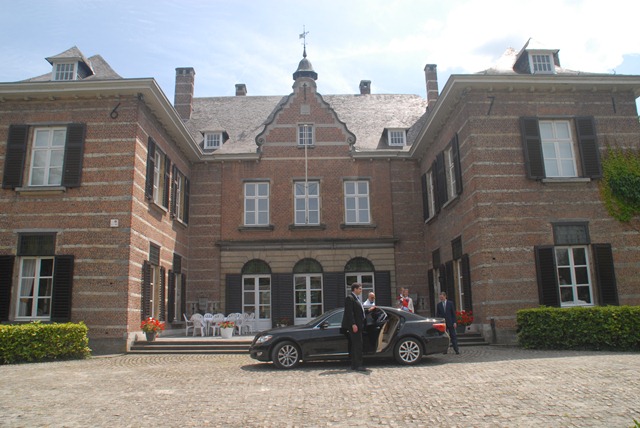
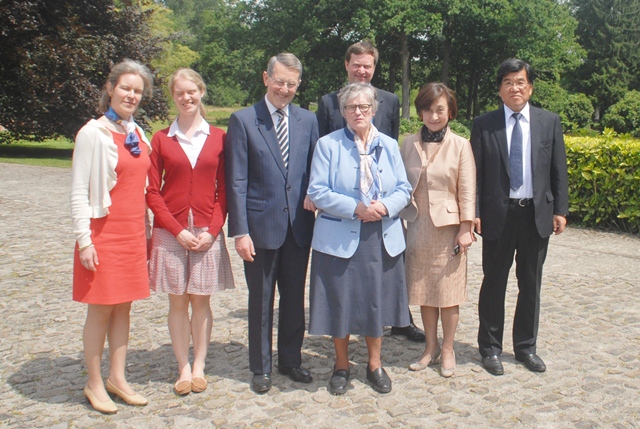 In the last Chat of the Ambassador, I talked about my visit to the Plantin-Moretus Museum in Antwerp (UNESCO World Heritage site). I was invited at the time to the Moretus family’s residence where I was treated for lunch. The residence is about 10 km southeast from Antwerp in the small town of Boechout. The residence is an old castle that was built in the 17th century. My wife and I came by car and as soon as we passed the main gate we almost lost our way as the estate was so large. Inside there were several salons, and one of them was decorated with Chinese antiquities. The families of the son and daughter also joined us for lunch and made for an interesting lunch meeting. The husband, Reynald Moretus Plantin de Bouchout is a businessman and currently is the honorary president of the Association de la Noblesse du Royaume de Belgique. Several generations back, the printing company that was in the hands of his ancestors’ family apparently closed down in the late-19th century after three-hundred years of existence. His wife was brought up in the noble family of Limburg-Stirum. She was taught by a home teacher during her childhood at home and did not go to a school. I was surprised to hear that even now she has trouble counting numbers. In the Chat of the Ambassador series I have introduced several families of nobility that live in old castles, but the Moretus family truly is the embodiment of such Belgian nobility.
In the last Chat of the Ambassador, I talked about my visit to the Plantin-Moretus Museum in Antwerp (UNESCO World Heritage site). I was invited at the time to the Moretus family’s residence where I was treated for lunch. The residence is about 10 km southeast from Antwerp in the small town of Boechout. The residence is an old castle that was built in the 17th century. My wife and I came by car and as soon as we passed the main gate we almost lost our way as the estate was so large. Inside there were several salons, and one of them was decorated with Chinese antiquities. The families of the son and daughter also joined us for lunch and made for an interesting lunch meeting. The husband, Reynald Moretus Plantin de Bouchout is a businessman and currently is the honorary president of the Association de la Noblesse du Royaume de Belgique. Several generations back, the printing company that was in the hands of his ancestors’ family apparently closed down in the late-19th century after three-hundred years of existence. His wife was brought up in the noble family of Limburg-Stirum. She was taught by a home teacher during her childhood at home and did not go to a school. I was surprised to hear that even now she has trouble counting numbers. In the Chat of the Ambassador series I have introduced several families of nobility that live in old castles, but the Moretus family truly is the embodiment of such Belgian nobility.

